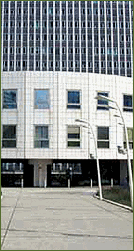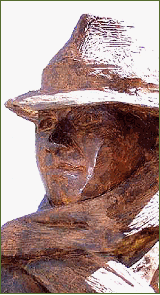|
The Musée Jean Moulin is situated in the 15th Arrondissement of
Paris and is located in the Jardin Atlantique above the tracks of the Montparnasse train
station, Gare Montparnasse and brings to life the reality of the war and this time in the history of Paris, plus it is a centre for research as well.
This museum is a place of documentation, information and research which is open to the
public, but is used extensively by researchers, schools and institutions, plus for those
that were involved in the 2nd World War, it is also a place of reflection.
The Musée Jean Moulin records the life and activities of Jean Moulin, who was the
recognised leader of the French Resistance Movement and now for a little background
information on him.
Jean Moulin was born in 1899 and was appointed the prefect of the Eure-et-Loire region in
1939, but he refused to co-operate with the German Army when it occupied France and was
arrested by the German Army for his refusal to sign certain documents. He was then
tortured and even attempted suicide by slitting his own throat, but soon after this he was
released from prison but still refusing to co-operate, so the Vichy Government had him
removed from office.
Jean Moulin was soon meeting with other French people such as Henry Frenay, who had
organised the most important of the early Resistance groups called Combat, that were
working to expel the Germans from France, then in 1941 he went to London under the assumed
name of Joseph Jean Mercier.
There he met with Charles de Gaulle who was leader of the Free French forces, but in exile
and he asked Jean Moulin to head the Resistance movement and hence in January 1942 he
parachuted back into France where he united the Resistance and his effort helped to keep
France from the same sort of civil conflicts that had afflicted other places like Poland
during the war.
But in June 1943 Jean Moulin was arrested by the Germans whilst in a meeting with other
Resistance leaders in the Rhône region and was taken first
of all to Lyon and interrogated, then to Paris and
interrogated by the head of the Gestapo.
Jean Moulin never told the Gustapo anything even though he suffered many severe injuries
from the torture and it was while he was on a train to a concentration camp in the July of
1943 that he died from those injuries.
He was buried in the Père Lachaise Cemetery,
but on 19th December 1964, his ashes were moved to the Panthéon
where they still remain today.
The Mémorial du Maréchal Leclerc de Hauteclocque et de la Libération de Paris - Musée Jean Moulin, was
inaugurated on 24th August 1994 by the Mayor of Paris, Jacques Chirac, which was the 50th
anniversary of the Liberation of Paris from the German Occupation.
This museum is an incredible place that not only has exhibits like underground newspapers,
leaflets and photographs, but also visual and audio displays that really let the visitor
experience what it was like to be involved with the Resistance, along with the events that
led to the Liberation of Paris and they are very moving presentations.
The Musée Jean Moulin is one of the lesser known museums in
Paris and as well as the permanent displays there are also temporary exhibitions held
there at different times of the year, plus there is a documentation centre, which is
available by appointment.
The museum is open on a Tuesday through to a Sunday from 10am.to 6pm, but it is closed on
a Monday and on national holidays.
Address & Contact Details:
Musée Jean Moulin
23, Allée de la 2e Division Blindée
Jardin Atlantique (covering la Gare Montparnasse)
75015
Paris
France
Telephone number: 1 40 64 39 44
|
|



